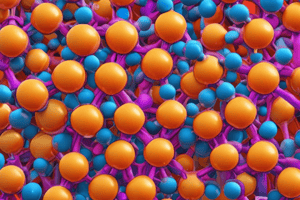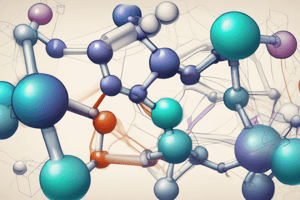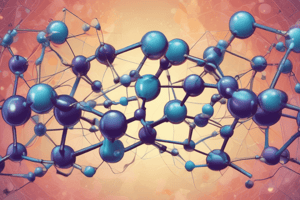Podcast
Questions and Answers
What is the heterocyclic analogue of benzene?
What is the heterocyclic analogue of benzene?
- Pantoprazole
- Nicotine
- Pyridine (correct)
- Vitamin B6
What is the role of pyridine in biological processes?
What is the role of pyridine in biological processes?
- Energy storage molecule
- Structural component of cell membranes
- Coenzyme in oxidation/reduction reactions (correct)
- Hormone regulator
Why is pyridine an aromatic heterocycle?
Why is pyridine an aromatic heterocycle?
- It has a nitrogen atom
- It is stable and reacts by substitution (correct)
- It has a six-membered ring
- It is unstable and reacts by addition
What is the effect of the N atom on pyridine's electronic structure?
What is the effect of the N atom on pyridine's electronic structure?
What is a characteristic of pyridine's resonance structures?
What is a characteristic of pyridine's resonance structures?
How does pyridine compare to benzene in terms of reactivity to substitution and nucleophilic reactions?
How does pyridine compare to benzene in terms of reactivity to substitution and nucleophilic reactions?
What is a characteristic of pyridine's methyl groups?
What is a characteristic of pyridine's methyl groups?
Why is pyridine more easily reduced than benzene?
Why is pyridine more easily reduced than benzene?
What is the pH at which the reaction is performed?
What is the pH at which the reaction is performed?
What is the duration of the reaction?
What is the duration of the reaction?
What is the reagent used in the reaction?
What is the reagent used in the reaction?
What is the functional group attached to the nitrogen atom?
What is the functional group attached to the nitrogen atom?
What is the intermediate formed during the reaction?
What is the intermediate formed during the reaction?
What is the leaving group in the reaction?
What is the leaving group in the reaction?
Why does the formation of pyridinium cation hinder further SE reactions?
Why does the formation of pyridinium cation hinder further SE reactions?
At which position does SE reaction in pyridine take place?
At which position does SE reaction in pyridine take place?
What is the reason for the easy displacement of halogen or nitro substituents at 2, 4, and 6 positions of pyridine by nucleophiles?
What is the reason for the easy displacement of halogen or nitro substituents at 2, 4, and 6 positions of pyridine by nucleophiles?
What is the reason for pyridine being difficult to nitrate?
What is the reason for pyridine being difficult to nitrate?
What is the intermediate anion stabilized by during the displacement of halogen or nitro substituents at 2, 4, and 6 positions of pyridine?
What is the intermediate anion stabilized by during the displacement of halogen or nitro substituents at 2, 4, and 6 positions of pyridine?
What is the role of HgSO4 in sulphonation of pyridine?
What is the role of HgSO4 in sulphonation of pyridine?
Why are pyridines more easily reduced than benzenes?
Why are pyridines more easily reduced than benzenes?
Why does Friedel-Crafts reaction not occur in pyridine?
Why does Friedel-Crafts reaction not occur in pyridine?
What is the effect of acidic solution on the oxidation of pyridine?
What is the effect of acidic solution on the oxidation of pyridine?
What is the effect of alkaline media on the oxidation of pyridine?
What is the effect of alkaline media on the oxidation of pyridine?
At which position does nucleophilic substitution occur in pyridine?
At which position does nucleophilic substitution occur in pyridine?
Why is nucleophilic substitution favored in pyridine?
Why is nucleophilic substitution favored in pyridine?
Why do pyridines have good leaving ability of the substituents?
Why do pyridines have good leaving ability of the substituents?
What is the temperature required for the reaction of pyridine with ammonia?
What is the temperature required for the reaction of pyridine with ammonia?
What is the mechanism of nucleophilic substitution in pyridine?
What is the mechanism of nucleophilic substitution in pyridine?
What is the reason for the resistance of pyridine to oxidation in general?
What is the reason for the resistance of pyridine to oxidation in general?
Why is pyridine less basic than corresponding aliphatic amines?
Why is pyridine less basic than corresponding aliphatic amines?
What is a characteristic of pyridine as a solvent?
What is a characteristic of pyridine as a solvent?
What is the product of the reaction between pyridine and alkyl halides?
What is the product of the reaction between pyridine and alkyl halides?
Why is pyridine unreactive to electrophilic substitution reactions?
Why is pyridine unreactive to electrophilic substitution reactions?
What is the product of the reaction between pyridine and percarboxylic acids?
What is the product of the reaction between pyridine and percarboxylic acids?
What is the reason for pyridine's ability to catalyze reactions in which acids are eliminated?
What is the reason for pyridine's ability to catalyze reactions in which acids are eliminated?
What type of compounds does pyridine form with Lewis acids?
What type of compounds does pyridine form with Lewis acids?
What is the difference between the orbital occupied by the lone pair of electrons in pyridine and aliphatic amines?
What is the difference between the orbital occupied by the lone pair of electrons in pyridine and aliphatic amines?
Flashcards are hidden until you start studying
Study Notes
Six-Membered Ring Heterocycles with One Nitrogen Atom
Pyridine and Pyridine Derivatives
- Pyridine (C5H5N) is the heterocyclic analogue of benzene (C6H6), derived by substituting -CH= with -N=.
- Pyridine is an aromatic heterocycle, stable, and reacts by substitution.
- Its ring H's are deshielded in the NMR spectrum (δ= 6.8 - 8.5 ppm).
Importance of Pyridine
- Pyridine plays a key role in several biological processes (e.g., NAD and pyridoxine (Vitamin B6)).
- It exists in several alkaloids (e.g., nicotine) and many synthetic drugs (e.g., Pantoprazole sodium).
Resonance of Pyridine
- The N atom has –I effect via σ bond and -M effect via π bond.
- Contributing structures: A, B, C, D, E, and Hybrid structure.
Chemical Reactions of Pyridine
- Pyridine is basic, has decreased reactivity to SE reactions, and increased reactivity to SN reactions.
- It is more easily reduced and more resistant to oxidation reactions.
- Methyl groups at 2-, 4-, and 6-positions are more reactive.
Basic Properties of Pyridine
- Pyridine is basic due to an electron pair on nitrogen available for bond formation with acids or electrophiles.
- Pyridine is less basic than corresponding aliphatic amines (e.g., piperidine) due to its sp2 orbital being more electronegative.
Examples of Basic Properties
- Pyridine reacts with acids to give stable salts.
- Alkyl halides react with pyridine to form quaternary pyridinium salts.
- Acyl and arylsulphonyl halides react with pyridine to form quaternary salts.
- Pyridine forms stable coordination compounds with Lewis acids.
- Pyridine reacts with percarboxylic acid to give pyridine-N-oxide.
Electrophilic Substitution (SE) at Ring Carbon Atoms
- Pyridine is very unreactive to SE reactions due to the -I effect of the N atom.
- The intermediate σ-complex is destabilized by the -I effect of the N atom.
- SE reactions occur at position 3- or 5- (β-position) due to the least disfavored σ-complex.
- Examples of SE reactions: nitration, sulphonation, halogenation, and Friedel-Crafts reactions.
Nucleophilic Substitution in Pyridine
- Direct Nucleophilic Substitution occurs at C2, C4, and C6 due to the electron-deficient ring C's.
- The intermediate anion is stabilized by resonance.
- Examples of SN reactions: C2 Attack, C4 Attack, and Br/NH2 substitution.
Reaction of Pyridine with Reducing Agents
- Pyridines are more easily reduced than benzenes.
Reaction with Oxidizing Agents
- Pyridines are resistant to oxidation in acidic solution.
- In alkaline media, pyridines are more rapidly oxidized than benzenes.
- Examples of oxidation reactions: CH3CHO and EtOOC-CH2-COOEt.
Studying That Suits You
Use AI to generate personalized quizzes and flashcards to suit your learning preferences.




